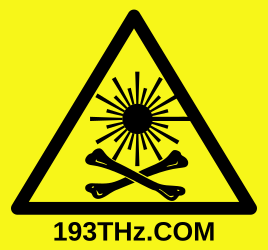
June 2025
As I have been unable to load an ion trap that repurposes an evaporable barium getter (intended for cathode-ray tubes) as an ion source using a Lasertechnik Berlin MNL100 nitrogen laser, I have been looking for something beefier to hit the barium source with. The fiber laser sources popular with laser engravers are an interesting and very inexpensive option (much cheaper than a new MNL100 and about half the price of a worn-out second-hand one) so I acquired the smallest unit made by Raycus, the RFL-P20QS, in order to see what could be done with it.
Note that this kind of laser is very dangerous, and proper safety eyewear must be used at all times - even the few-% reflection of the beam from a piece of uncoated glass would be enough to cause serious eye damage. Also make sure that the output port is pointing in a safe direction before turning on the unit. The emitted beam is well-collimated, and could cause damage at a considerable distance.
As per the pinout in the manual, the minimum required to get the laser to operate is to apply 5V to pins 18 and 19 of the DB25 interface and to one or several of pins 1-8 to set the desired power level, using any of the specified pins (e.g. 10, 24 or 25) as ground. You'll need to drive a total of a few dozens milliamps as those pins are connected to the LEDs of optocouplers. Confusingly and contrary to what the manual says, pin 22 does nothing as the Raycus QS series do not contain a red guide laser, but you'll still be able to drive current into the optocoupler connected to that pin - the controller board is likely reused across several laser models. It is more economical to equip an external guide laser using a dichroic mirror, as the Raycus units that contain it are considerably more expensive and these external parts are available at low prices from fiber engraver shops - though their alignment can be time-consuming and frustrating.
The covers can be opened easily by removing the screws on their sides. Under the top one is where the optics are located, and the bottom part of the unit contains the (less interesting) electronics and two pump diodes.
Despite its low price, this laser is actively Q-switched using an acousto-optical modulator (AOM). This is quite remarkable considering that the entire laser is about half the typical price of a fiber-coupled AOM from most Chinese suppliers. The laser uses a "master oscillator power amplifier" (MOPA) architecture, presumably to deal with limitations in optical power handling capacity of components such as the AOM. The AOM is driven from the bottom side of the unit using this "HRY-DQ120M(B)" module, which unlike the other PCBs does not appear to have been made by Raycus. But I have not been able to identify its manufacturer, nor that of the AOM. This AOM driver contains a crystal oscillator which is then amplified by the unusual chip-on-board RFPA, and the modulation appears to be done by changing the bias point of the RFPA. The AOM driver is mounted on the central heatsink of the unit with a heat-conductive pad. Its output consists in bursts of a 120MHz sine wave at a repetition frequency equal to the pulse rate of the laser (60kHz).
One point to note is that the acousto-optical Q-switch is continuously being pulsed, even when the laser is disabled through its DB25 interface. So while the unit should be eventually capable of producing a stable, well-timed train of pulses (which would help with ion trapping), it would seem that the timing (and other characteristics) of the first laser pulse is indeterminate. The pump ramp-up time is also likely slower than the ˜17μs Q-switch pulse period.